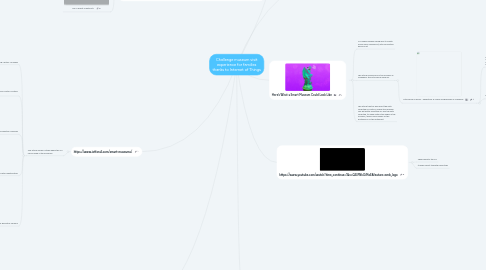
1. https://www.iotforall.com/smart-museums/
1.1. This article shows 5 steps where the IoT can be used in the museums
1.1.1. Stage 1: Tracking Visitors’ Journeys
1.1.1.1. For example, a report from the Louvre museum in Paris may show: “90% of today’s visitors have entered Space A, which contains the Mona Lisa, while 25% of the visitors that day have entered Space B, which contains pieces from upcoming local artists.”
1.1.2. Stage 2. Real-Time Visitor Location Tracking
1.1.2.1. Attention point is earned by the piece of art whenever a visitor walks through its attention spot.
1.1.2.2. Points whenever a visitor walks through the attention spot very slowly.
1.1.2.3. Points whenever a visitor stands still for one second, and more points the longer he or she stands still.
1.1.2.4. Points whenever a visitor walks up for closer inspection.
1.1.3. Stage 3: Facial Recognition Cameras
1.1.3.1. Whether and how long an individual visitor is paying attention to the piece of art (and even to which part of it).
1.1.3.2. The visitor’s demographics: age, sex, height, weight, ethnicity, etc.
1.1.3.3. The visitor’s emotions: joy, disgust, surprise, discomfort, horror, etc.
1.1.3.4. The combination of all viewed pieces of art in the smart museum by the visitor, creating unique visitor preferences profiles.
1.1.4. Stage 4: Visitor Identification
1.1.4.1. From using this newly acquired data, a museum report can now read: “Daan de Geus from Amsterdam smiled while paying attention to the Mona Lisa for 113.6 seconds. This attention span is 34% longer than the average for his visitor archetype. From analyzing the preferences of Daan’s 481 Facebook friends (through their ‘likes’), we identified that 16 of Daan’s friends might find the Mona Lisa interesting. Two of these friends have already shared pictures taken inside the Louvre last month. I have therefore automatically paid Facebook to advertise the Mona Lisa on the social media profiles of Daan’s relevant 14 friends.”
1.1.5. Stage 5: Biometric Sensors
1.1.5.1. Heartbeat. Here we measure the pulse of visitors through pulse sensors from a distance, allowing us to measure (the average) change in heartbeat per space or per piece of art.
1.1.5.2. Temperature. Certain emotions have shown to lead to changes in temperature across specific areas of the face and body. By adding thermal infrared to our facial recognition cameras, we can pick up on changes in emotional state at a deeper level.
1.1.5.3. Tone of Voice. Microphones can be installed to allow us to analyze the tone of voice of the visitor. An above-average high-pitched tone of voice around a piece of art can be an indicator of a specific emotion. Note that this does not track what is said, just how it is said.
2. https://www.museumofthefuture.ae/application/files/cache/2e17dfec82133c74037c2f36c5b10d91.jpg
2.1. Museum are the expression of human creativity
2.1.1. What would happen if the AI could create art as humans do?
2.1.2. Will it be able to create a museum by itself
2.1.3. A 100% automated museum that would be created by robots interacting with each other
2.1.4. could be a vey unique experience
2.2. Can A Robot Create Art?
3. Libelium’s IoT technology contributes to heritage preservation monitoring of two historic masterpieces | Libelium
3.1. Museum is also about preserving arts, the internet of things might help museums to learn more about their paints and other arts, about the history, helping the scientist to find details about the arts that would explain some historical facts
3.1.1. IoT and Museum can help have information about the past collecting data and analyse it
4. AI Is Blurring the Definition of Artist
4.1. If artificial intelligence is used to create images,can the final product really be thought of as art?
4.1.1. The original definition of art was from the word "artisan"
4.1.2. it imply the work with the hand, it imply technics
4.1.3. can we say that robots can be treated as human?
4.1.3.1. The following discussion between random users is interesting and give us a glance about the public oppinion
4.1.3.1.1. https://www.researchgate.net/post/Can_robots_ever_behave_like_humans
5. Here’s What a Smart Museum Could Look Like
5.1. IoT makes museum being able to create much more complex art, inter connected piece of art
5.2. The article reminds me of the museum in Singapore: the ArtScience museum.
5.2.1. ArtScience Museum - Exhibitions & School Programmes in Singapore
5.2.1.1. As we can see, museum and IoT can be used to teach thing to children, and it make it very interesting and ludique for the children which help them concentrate.
5.2.1.2. FUTURE WORLD at ArtScience Museum, Singapore
5.3. The article treat as well about the data collected on visitors, maybe the museum can get better using the IoT and the data collected, to make visitor stay longer in the museum, spend more money on the boutique or on the restaurant.
6. https://www.youtube.com/watch?time_continue=1&v=QSIPNhOiMoE&feature=emb_logo
6.1. Shows what is the IoT
6.2. It helps object talk with each other
7. https://www.researchgate.net/publication/330229361_Proposed_open_source_framework_for_interactive_IoT_smart_museums
7.1. This conference talks about the fact that the IoT framework for museum could be Open source
7.1.1. If the framework is Opensource the cost for the museum won't be important therefore a lot of

